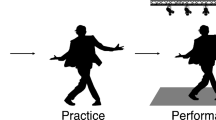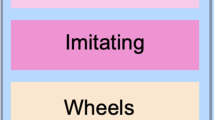This chapter seeks to explore the development of an ambient intelligent dance space. In particular, the chapter proposes intelligent systems that use non-linear optimization as well as symbolic rule-based systems to adjust sound/music, on-stage lighting, and projected visual imagery in terms of movement and color to dynamically reflecting the dancer’s arousal state measured through physiological sensors worn by the dancers. To aesthetically adjust physical lighting around the dancers, dancer’s location will need to be identified. This variable will be identified using pressure sensor mats installed on the floor to track dancers’ movements. Data from these sensors will be passed into a three layered architecture. Layer 1 is composed of a sensor analysis system that analyzes and synthesizes physiological and pressure sensor signals.
Access this chapter
Tax calculation will be finalised at checkout
Purchases are for personal use only
Preview
Unable to display preview. Download preview PDF.
Similar content being viewed by others
References
Aktas, G., & Ogce, F. (2005). Dance as a therapy for cancer prevention. Asian Pac J. Cancer Prev, 6(3), 408-411.
Alton, J. (1995). Painting with Light. Berkeley: University of California Press.
Birn, J. (Ed.). (2000). Digital Lighting & Rendering. Indianapolis: New Riders.
Block, B. (2001). The Visual Story: Seeing the Structure of Film, TV, and New Media. New York: Focal Press.
Bordwell, D., & Thompson, K. (2001). Film Art: An Introduction (6th ed.). New York: Mc Graw Hill.
Brown, B. (1996). Motion Picture and Video Lighting. Boston: Focal Press.
Calahan, S. (1996). Storytelling through lighting: a computer graphics perspective. Paper presented at the Siggraph Course Notes.
Calvert, T., & Mah, S. (1996). Life Forms: an Application of Computer Graphics to Support Dance Choreography. Paper presented at the Siggraph 96 Visual Proceedings: The art and interdisciplinary programs of Siggraph, New Orleans, LO.
Cheshire, D., & Knopf, A. (1979). The Book of Movie Photography. London: Alfred Knopf, Inc.
Clark, A. (2001). Adaptive Music. Gamasutra.com, May 15, 2001.
Cooper, D. (1995). Very Nervous System. Wired.
Crawford, J., Schiphorst, T., Gotfritt, M., & Demers, L. P. (1993). The Shadow Project. Paper presented at the Symposium on Arts and Technology.
Crow, F., & Csuri, C. (1985). Music and Dance Join a Fine Artist and a Paint Machine. IEEE Computer Graphics and Application, 11-13.
Crowther, B. (1989). Film Noir: Reflections in a Dark Mirror. New York: Continuum.
Cunningham, M., Kaiser, P., & Eshkar, S. (1998). Hand-drawn Spaces. Paper presented at the Siggraph 1998, Special Sessions.
Demers, L. P. (1993). Interactive and Live Accompaniment Light for Dance. Paper presented at the Dance and Technology Conference, Simon Fraser University, Vancouver.
Demers, L. P., & Jean, P. (1997). New Control Approaches on Lighting. Paper presented at the Shadow Light ’97, Flemish Opera House.
Demers, L. P., & Vorn, B. (Artist). (1998). Lost Referential [Exhibition].
Flores, R. (1995). Dance for Health: Improving Fitness in African American and Hispanic adolescents. Public Health Rep., 110(2), 189-193.
Forbus, K., Kleer, J. De. (1993). Building Problem Solvers. Cambridge: MIT Press.
Gillette, J. M. (1998). Designing with Light (3rd ed.). Mountain View, CA: Mayfield.
Gruen, J. (1983). Dancevision. Dance Magazine, 57, 78-79.
Hill, B. H., Roger, T., and Vorhagen, F. W. (1997). Comparative Analysis of the Quantization of Color Spaces on the Basis of the CIELAB Color-Difference Formula. ACM Transactions on Graphics, 16(2), 109-154.
Jeong, Y. J., Hong, S. C., Lee, M. S., Park, M. C., Kim, Y. K., & Suh, C. M. (2005). Dance movement therapy improves emotional responses and modulates neurohormones in adolescents with mild depression. International J. of NeuroScience, 115(12), 1711-1720.
Katra, E. a. W., B. R. (1995). Preceived lightness/darkness and warmth/ coolness in chromatic experience. Unpublished manuscript.
Luo, M. R., Cul, G., and Rigg, B. (2000). The Development of CIE 2000 Colour Difference Formula: CIEDE2000, 2000, from http://www.ifra.com/Website/ ifra.nsf/html/colorqualityclub.html.
Meador, S., Rogers, T. J., O’Neal, K., Kurt, E., & Cunningham, C. (2004). Mixing Dance Realities: Collaborative Development of Live-Motion Capture in a Performing Arts Environment. ACM Computers in Entertainment, 2(2).
Miller, M. (1997). Producing Interactive Audio: Thoughts, Tools, and Techniques. Gamasutra.com, October 15, 1997.
Millerson, G. (1991). The Technique of Lighting for Telivision and Film (3rd ed.). Oxford: Focus Press.
Noreau, L., Martineau, H., Roy, L., & Belzile, M. (1995). Effects of a modified dance-based exercise on cardiorespiratory fitness, psychological state and health status of persons with rheumatoid arthritis. American Journal of Phys Med Rehabil, 74(1), 19-27.
Patterson, S. (2001). Interactive Music Sequencer Design. Gamasutra.com, May 15, 2001.
Rokeby, D. (1986). Very Nervous System, from http://homepage.mac.com/ davidrokeby/vns.html.
Rokeby, D. (Artist). (1986-1990). Very Nervous System.
Ross, R. (2001). Interactive Music … et, Audio. Gamasutra.com, May 15, 2001.
Srinivasan, P., Birchfield, D., Qian, G., & Kidane, A. (2005). A Pressure Sensing Floor for Interactive Media Applications. Paper presented at the ACM SIGCHI International Conference on Advances in Computer Entertainment Technology (ACE), Valencia, Spain.
Ulyate, R., & Bianciardi, D. (1998). Interactive Dance Club. Paper presented at the Siggraph 98, Orlando, Florida.
Ulyate, R., & Bianciardi, D. (2001). The Interactive Dance Club: Avoiding Chaos in a Multi Participant Environment. Paper presented at the CHI ’01 Workshop New Interfaces for Musical Expression (NIME ’01).
Vasilakos, A., & Pedrycz, W. (2006). Ambient Intelligence, Wireless, Networking, Ubiquitous Computing. MA, USA: Artech House Press.
Wagner, M. G., & Carroll, S. (2001). DeepWave: Visualizing Music with VRML. Paper presented at the Proceedings of the Seventh International Conference on Virtual Systems and Multimedia (VSMM ’01).
WinAmp. from www.winamp.com.
Windows Media Player. from www.microsoft.com.
Winkler, T. (1995). Making Motion Musical: Gesture Mapping Strategies for Interactive Computer Music. Paper presented at the Proceedings of International Computer Music Conference.
Winkler, T. (1997). Creating Interactive Dance with the Very Nervous System. Paper presented at the Proceedings of Connecticut College Symposium on Arts and Technology.
Winkler, T. (1998). Motion-Sensing Music: Artistic and Technical Challenges in Two Works for Dance. Paper presented at the Proceedings of the International Computer Music Conference.
Author information
Authors and Affiliations
Editor information
Editors and Affiliations
Rights and permissions
Copyright information
© 2007 Springer-Verlag Berlin Heidelberg
About this chapter
Cite this chapter
El-Nasr, M.S., Vasilakos, T. (2007). DigitalBeing: An Ambient Intelligence Interactive Dance Experience. In: Lee, R.S.T., Loia, V. (eds) Computational Intelligence for Agent-based Systems. Studies in Computational Intelligence, vol 72. Springer, Berlin, Heidelberg. https://doi.org/10.1007/978-3-540-73177-1_8
Download citation
DOI: https://doi.org/10.1007/978-3-540-73177-1_8
Publisher Name: Springer, Berlin, Heidelberg
Print ISBN: 978-3-540-73175-7
Online ISBN: 978-3-540-73177-1
eBook Packages: EngineeringEngineering (R0)




